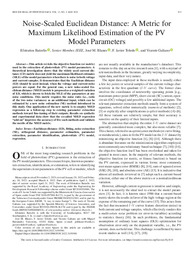Por favor, use este identificador para citar o enlazar este ítem:
https://hdl.handle.net/11000/30460
Noise-Scaled Euclidean Distance: A Metric for
Maximum Likelihood Estimation of the PV
Model Parameters
Título :
Noise-Scaled Euclidean Distance: A Metric for
Maximum Likelihood Estimation of the PV
Model Parameters |
Autor :
Batzelis, Efstratios 
Blanes, Jose M. 
Toledo Melero, Fco. Javier 
Galiano, Vicente  |
Editor :
IEEE Xplore |
Departamento:
Departamentos de la UMH::Ingeniería de Computadores |
Fecha de publicación:
2022-05 |
URI :
https://hdl.handle.net/11000/30460 |
Resumen :
This article revisits the objective function (or metric)
used in the extraction of photovoltaic (PV) model parameters. A
theoretical investigation shows that the widely used current distance (CD) metric does not yield the maximum likelihood estimates
(MLE) of the model parameters when there is noise in both voltage
and current samples. It demonstrates that the Euclidean distance
(ED) should be used instead, when the voltage and current noise
powers are equal. For the general case, a new noise-scaled Euclidean distance (NSED) metric is proposed as a weighted variation
of ED, which is shown to fetch the MLE of the parameters at any
noise conditions. This metric requires the noise ratio (i.e., ratio
of the two noise variances) as an additional input, which can be
estimated by a new noise estimation (NE) method introduced in
this study. One application of the new metric is to employ NSED
regression as a follow-up step to existing parameter extraction
methods toward fine-tuning of their outputs. Results on synthetic
and experimental data show that the so-called NSED regression
“add-on” improves the accuracy
|
Palabras clave/Materias:
Euclidean distance (ED)
fitting
noise extraction (NE)
orthogonal distance
parameter estimation
parameter extraction |
Área de conocimiento :
CDU: Ciencias aplicadas: Ingeniería. Tecnología |
Tipo de documento :
info:eu-repo/semantics/article |
Derechos de acceso:
info:eu-repo/semantics/openAccess |
DOI :
https://doi.org/ 10.1109/JPHOTOV.2022.3159390 |
Publicado en:
IEEE Journal of Photovoltaics, vol. 12, no. 3, may 2022 |
Aparece en las colecciones:
Artículos Ingeniería de computadores
|
 La licencia se describe como: Atribución-NonComercial-NoDerivada 4.0 Internacional.
La licencia se describe como: Atribución-NonComercial-NoDerivada 4.0 Internacional.

 La licencia se describe como: Atribución-NonComercial-NoDerivada 4.0 Internacional.
La licencia se describe como: Atribución-NonComercial-NoDerivada 4.0 Internacional.
.png)